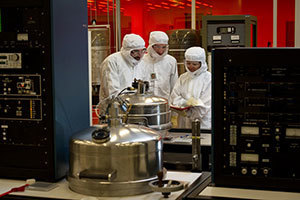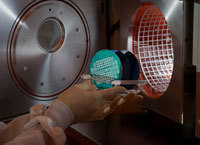The University of Notre Dame has been selected to lead one of six new university microelectronics research centers that will share $194 million in funding from the Semiconductor Research Corp. (SRC) and the Defense Advanced Research Projects Agency (DARPA) to support the continued growth and leadership of the U.S. semiconductor industry.
Notre Dame’s center is titled the Center for Low Energy Systems Technology (LEAST).
SRC, the world’s leading university-research consortium for semiconductors and related technologies, and DARPA as part of the Department of Defense, will administer the new Semiconductor Technology Advanced Research Network (STARnet) program. Over the next five years, $40 million will be dedicated annually to the program, with each center receiving about $6 million.
The STARnet program also will include centers led by the Universities of Michigan, Minnesota, Illinois Urbana-Champaign, UCLA and University of California Berkeley.
 Engineering professor Greg Snider, left, with graduate students in the Clean Room in Stinson-Remick Hall of Engineering.
Engineering professor Greg Snider, left, with graduate students in the Clean Room in Stinson-Remick Hall of Engineering.
“STARnet is a collaborative network of stellar university research centers whose goal is to enable the continued pace of growth of the microelectronics industry, unconstrained by the daunting list of fundamental physical limits that threaten,” said Gilroy Vandentop, the new program director.
Alan C. Seabaugh, professor of electrical engineering, Frank M. Freimann Director of the Midwest Institute for Nanoelectronics Discovery (MIND) and associate director of the Center for Nano Science and Technology, will lead the LEAST center.
“One of the greatest challenges facing our technological world today is the amount of energy consumed by electronics of all types, and the new Low Energy Systems Technology Center led by Alan will lead to new devices, circuits and architectures that consume considerably less energy,” said Peter Kilpatrick, McCloskey Dean of Notre Dame’s College of Engineering. “Alan and his team are making an enormous contribution to the world of the 21st century.”
LEAST will explore new concepts for dramatically lowering the power requirements for electronics.
“Today’s integrated circuits are limited by power dissipation,” Seabaugh says. “Anyone with a laptop feels the power dissipation as heat. In our data centers, this heat requires an extensive and costly cooling system which drains power from the grid. Heat now prevents us from packing more transistors onto a computer chip. The mission of LEAST is to discover devices which will run cooler and pack tighter. This will change the rules currently limiting how many transistors we can put on a chip and how fast we can operate them.”
The LEAST research team will consist of 26 researchers from Notre Dame and nine other universities: Carnegie Mellon, Georgia Tech, Purdue, Penn State, UC Berkeley, UC Santa Barbara, UC San Diego, University of Texas at Austin and UT Dallas.
 Research for Notre Dame’s new Center for Low Energy Systems Technology will take place in the Clean Room and other laboratories of Stinson-Remick Hall.
Research for Notre Dame’s new Center for Low Energy Systems Technology will take place in the Clean Room and other laboratories of Stinson-Remick Hall.
LEAST will build on research developed by the Notre Dame-led MIND (Midwest Institute for Nanoelectronics Discovery), a consortium designed to discover and develop the next nanoscale logic device, the basic building block of future computer technology. MIND was established in 2008 and was one of four centers supported by the SRC’s Nanoelectronics Research Initiative (NRI).
“One clear way to dissipate less energy in a transistor is to lower the voltage,” Seabaugh says. “This has been a research focus of MIND. MIND researchers have led the development of field-effect tunneling transistors, low-voltage devices which have now entered industrial research and development labs worldwide. This is a significant success story for the NRI. The tunnel transistor now enters a competitive development phase which will be fought out in the semiconductor industry.”
LEAST will now look to new material systems and new switching phenomena that can offer even lower voltage operation.
“Universities are now asked to look beyond the tunnel transistor,” Seabaugh says. “Are there ways to construct transistors at even smaller sizes and still lower voltages? The answer is clearly yes. It will require synthesis of new materials and development of new device fabrication processes. It will require more intimate understanding of electron transport in complex materials and devices.”
Seabaugh is optimistic that LEAST will continue MIND’s impressive record of achievement.
“We are excited to launch this new center which has an extraordinary team, some of the best and brightest researchers in the field,” he says. “We have a center-wide research focus that has everyone working together. We have experts in the semiconductor industry and the Department of Defense in collaboration. We have local partners, Innovation Park, Ignition Park, the city of South Bend and the state of Indiana to guide new technologies into new businesses. Expect great things.”
Contact: Alan Seabaugh, 574-631-4473, Alan.C.Seabaugh.1@nd.edu